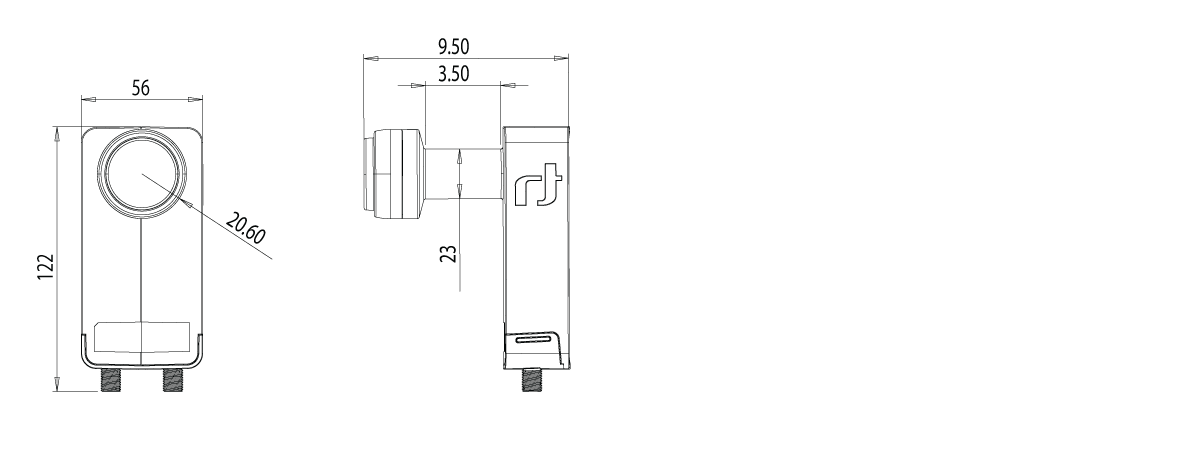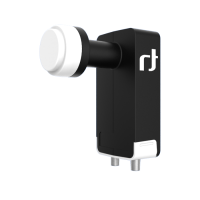This pioneering WHITE Ka LNB line was designed to enable reception of the new high bandwidth satellite TV, radio and data services in Ka band that are being launched across Europe. This Twin Ka Circular dual polarity LNB was specifically engineered to meet the reception requirements of Eutelsat for its KA-SAT satellite located on 9° East (e.g. Saorsat – Reception of free Irish TV by Satellite). The LNB features two IF outputs and supports connection to two different satellite receivers. The LNB was designed to be used with standard offset antennas of 60-90cm diameter and F/D or 0.6. The feed of this Twin LNB is designed to fit as close as 4 degrees to a allow reception from another satellite over the same dish in Europe (for example - universal Ku LNB receiving the popular Hotbird 13° East). The external diameter of the feed is about 23mm and it is supplied with 40mm ring adapter to ensure compatibility with standard dish antennas. This LNB is using the highest quality components to ensure outstanding and consistent performance and durability and is manufactured under rigorous test conditions and strict quality standards.
Main features:
- Pioneering LNBF for reception of satellite services over Ka band
- High Frequency and Gain stability
- Low Phase Noise
- Low Noise Figure
- Low power consumption
- High Cross-Pole performanc
KA-SAT downlink coverage

KA-SAT is the first High Throughput Satellite (HTS) in Europe and marks a new generation of multi-spotbeam high-capacity satellites. It is positioned at 9° East and covers Europe and the Mediterranean basin and has 82 tight Ka-band spot beams across Europe. Source: Eutelsat
To learn more on Eutelsat KA-SAT satellite – visit: http://www.eutelsat.com/satellites/9e_ka-sat.html
The LNB is suitable for the reception of Saorsat - Reception of Free Irish TV and Radio by Satellite. The Saorsat service is available via Ka-Sat @ 9E, using Ka-Band (Left Circular Polarised for Ka-Band on 20.185GHz). To learn more on Saorsat service – visit http://www.saorview.ie/
| Technical specifications | |
|---|---|
| Input frequency range | 19.7 GHz ~ 20.2 GHz |
| Output frequency range |
1500 MHz ~ 1000 MHz (spectrum inversion) |
| Low band LO frequency |
21.20 GHz |
| LO temperature drift | ±3.0 MHz Max. |
| LO initial accuracy | ±1.0 MHz Max. |
| Polarization |
Dual circular for Ka band (RHCP/LHCP) |
| LO phase noise @ 10 kHz |
-75 dBc / Hz max. |
| LO phase noise @ 100 kHz | -95 dBc / Hz max. |
| Conversion gain |
50 dB ~ 60 dB min. |
| Gain ripple (over 26 MHz bandwidth) | ±0.75 dB |
| Gain variation (over full band) | ±5 dB max. |
| Image rejection |
40 dB min. |
| 1 dB compression point (@ output) | 0.0 dBm min. |
| Cross polarization isolation | 22 dB min. |
| Polarization selection - LHCP | 13 V |
| Polarization selection - RHCP | 18 V |
| Output VSWR |
2.5 : 1 |
| In band spurious level | -60 dBm max. |
| Current consumption |
120 mA max. @ 11 V ~ 20 V |
| Operating temperature |
-30 °C ~ +60 °C |
| Output impedance |
75 Ω |
| Output connector type |
F-Type (female) |
| Weight | 181 g |
| Logistical info | |
| Packaging dimensions (W x D x H) | 11 x 12,2 x 6,7 cm |
| Packaging weight | 0,27 kg |
| Quantity per Carton | 40 pcs |
| Carton dimensions (W x D x H) | 74 cm x 26 cm x 23.5 cm |
| Carton weight | 11,80 kg |
| Quantity per pallet | 960 pcs |





The feedhorn is a part of the LNB and works like a directional horn. Its function is to capture the signals reflected from the dish and to shield the LNB from receiving extraneous radiation from other sources. These collected signals are then passed form the horn to the electronics within the LNB.
HsQuare is a unique waveguide technology which may be coupled with a slightly larger feed horn design to deliver better RF performances compared with common circular microwave waveguides.

